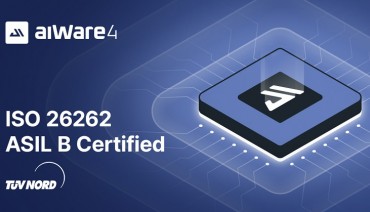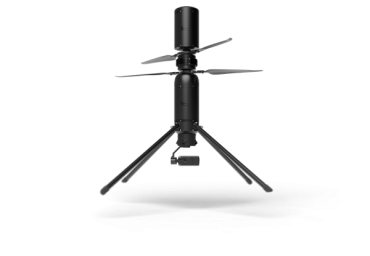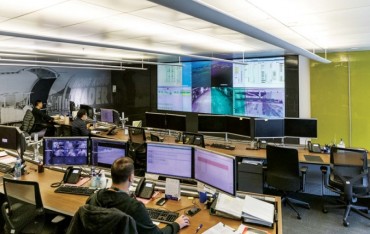
Businesses that have hazardous areas are under increasing pressure to improve operational efficiency without compromising safety. (image: wikipedia)
ASSAMSTADT, GERMANY, May 13 (Korea Bizwire) – Today, industry stands on the brink of its fourth major technological revolution, Industry 4.0, having previously implemented several major changes — mechanisation, mass production and electronic automation. This new age will encompass industrial-strength wireless communications, digital networks and wirelessly connected devices, often referred to as the Industrial Internet of Things (IIOT).
Understandably, many companies are unsure of the steps they need to take on this new road — this is especially the case amongst businesses that have hazardous areas and are under increasing pressure to improve operational efficiency without compromising safety.
So, how do companies handle these challenges and what are some of the emerging technologies which will enable process improvement in hazardous areas? To answer these questions, we interview Sebastian Kaul, Product Manager at ecom instruments GmbH, who offers some insight into the road ahead and tips for how to overcome some of these challenges.
1. What challenges will industrial companies face concerning their working practices and safety procedures?
In our everyday lives, wireless connectivity and digital networks are something we all depend on to keep in touch, send email, and send texts. Who would want to go back to the days when letters and faxes were the most common way to communicate, with the inherent delays and inefficiencies? Likewise, paper books are becoming a thing of the past as many of us transition to e-readers and smartphones, providing a more environmentally friendly alternative.
This being said, many industrial companies today continue to use yesterday’s technologies to plan, execute, manage and control their business processes. Due to a lack of alternatives or purely out of habit (“we’ve always done it this way”), many tasks are still performed with clipboard and paper. These archaic methods bring increased risk and inflexibility to the business, being error-prone and inefficient. They also lead to mobile workers carrying more when walking around the plant or rig site, creating a potential safety issue and increasing the strain on them.
To compete in today’s markets, companies must strive for more efficient, faster and safer ways to produce quality products and deliver services, using less people and allowing more of the workforce to be focused on value-adding tasks. As a result, companies are turning to mobile computing devices (tablets, smartphones, PDAs) to improve process efficiency and enable real-time visibility to allow near real-time decision making.
However, the ever-increasing number of digital communication systems also means that mobile devices must meet greater user expectations — supporting various wireless connectivity types (WiFi, cellular, Bluetooth, RFID) in the same device. For sites where digital radios are still in use, mobile devices must also support connection to these radios using a software application.
2. What are the disadvantages of traditional methods related to field working practices?
Many printed documents contain sensitive information which could do harm to the business in the wrong hands. Documents also need to be revised to reflect changes to the plant or working practices since the field worker relies on the documents they carry. In case of unforeseen maintenance issues, the required information may not be present in the documents at hand when needed — potentially resulting in delays, safety incidents, or the wrong part being ordered and used.
And, information gathered directly on location during inspection and maintenance tasks is written onto paper in the field and later added to a software database system or a paper storage cabinet — a time consuming and tedious workflow with high error potential.
3. What are the alternatives to this approach?
Many of these challenges can be solved with the use of mobile devices.
Accurate and timely information regarding the position and condition of mobile workers, equipment and material related to hazardous areas are critical for all companies, allowing better visibility and control to prevent unplanned downtime, waste and safety incidents.
Transparent processes, up to date accuracy and realtime visibility are difficult, costly and often impossible to achieve with pen and clipboard. However, all is not lost — mobile computing devices offer a solution to this dilemma.
4. What advantages do mobile devices bring to industrial workflows?
For the first time, mobile workers working in hazardous areas don’t have to find, print and carry paper forms, documents, drawings and diagrams out into the field where they can get wet and become difficult to read.
Using a smartphone, tablet or handheld computer designed for use in hazardous areas, the worker can simply scan the attached barcode or RFID tag to retrieve current information about the status of machines or their parts on the screen of the device.
With a WiFi or Cellular connection, the mobile worker communicates in real time with the specialist staff located at the control center, reports any damage, retrieves information on demand and receives guidance. Additionally, any data updates made in the field are transferred directly into the company systems, allowing quicker decision making and reduced unplanned downtime.
Furthermore, the technicians are much better protected on site by the permanent connection to the control center — lone worker protection systems can warn the control center automatically when a worker has an accident or can notify and warn the worker of any hazards as they move into an area.
5. Which processes can be optimised using mobile devices?
There are so many potential applications, it is often difficult to decide which one to implement first. Typical applications include the tracking and control of plant, testing machines and equipment as well as containers, tools and inventory management, supply chain management, inspection rounds, maintenance and repair, and plant safety inspections.
Advantages related to these applications are lower user fatigue, improved utilisation, ongoing transparency of data in real time, easier item location, reduced security risk and a reliable base for decision making and thus greater profitability.
6. Which requirements does a mobile device need to fulfill in order to succeed in professional use?
In addition to the certification for hazardous areas, the devices must be extremely robust and withstand falls, water and dirt. It is also necessary to ensure an above-average battery life and display readability in direct sunlight.
7. Why not use consumer mobile devices in industrial areas?
A standard consumer device is neither tough enough nor is the material quality or battery life designed for a worker’s full 12 hour shift under extreme conditions. A study by VDC Research concludes that the average failure rate per year of a non-rugged mobile device is 38%, whilst a robust mobile device is only 11%.
Moreover, in very noisy working environments, incoming calls and audible alerts cannot be heard and a two-way conversation cannot easily take place without background noise cancellation which is typically included in industrial headsets.
Consumer devices also do not have the required approvals and certification to permit use in hazardous areas, potentially introducing a safety risk to the facility.
8. What specific challenges need to be addressed when using mobile devices in hazardous zones?
Hazardous areas are categorised into “Hazardous Zones” based on the risk determined by the likelihood of an explosive atmosphere within these zones — for example, a mixture of air with flammable substances in the form of gas, vapor or mist during normal operation. Zone 1 and Zone 2 respectively indicate that an explosive atmosphere occurs regularly or rarely.
To avoid an explosion or safety incident, no ordinary unprotected consumer device should be used within these zones. A misconception is that a consumer device can be used with a portable gas detector — if gas is detected, it may be too late if this same gas has found its way inside the mobile device.
Even when these devices are switched off and robust enough to withstand the harsh environment, the battery and some unprotected circuits remain live or powered on, increasing the safety risk to the facility.
Mobile devices which have been designed for use in hazardous areas include complex modifications and undergo intensive testing (especially for Zone 1) before they attain global certification and approvals.
9. What requirements must be fulfilled when a mobile device is to be used in hazardous areas?
Many devices which meet the general MIL-STD-810G standard do not undergo the same high level of testing as a Zone 1 certified device must undergo and pass. To meet MIL-STD-810G standards, it is possible to use a new device for each test scenario, reducing the stress that any one device will undergo.
However, this is not the case for a Zone 1 device, where the same serialised device must pass all of the test runs. These tests include an artificial aging test at high temperatures and humidity followed by drop tests with various temperature variations — this puts a much higher level of stress on the device compared to MIL-STD-810G. As a result, the requirement for permanent and diverse ruggedness in hazardous areas is significantly higher, providing an extraordinary level of durability as well as hazardous area safety protection that can be relied upon.
10. What alternatives are there to conventional robust mobile phones that are suitable for use in harsh and hazardous environments?
For users who need an advanced mobile phone, we recommend the Ex-Handy®09. Like a mobile phone, it provides both a keyboard and a touch screen for user interaction and data entry. Unlike some phones, standard Android applications can run on the Ex-Handy®09, including Lone Worker Protection and Push-To-Talk applications.
11. What advantage does a certified Smartphone bring to hazardous area tasks?
Not all certified Smartphones are alike, however the Smart-Ex®01 is equipped with the latest 4G/LTE technology to modernise, accelerate and simplify the communication and collaboration between mobile workers, the experts at the control center and the back-end systems.
This new higher level of online connectivity and coverage leads to more effective work processes, reduced downtime and costs, increased security, and streamlines decision-making processes. Also, Smart-Ex®01 is provided SIM-free and unlocked, allowing you to choose the network provider for the device or use the device within your existing network contract.
Smart-Ex®01 uses the latest Android 4.4 operating system, supporting a wide selection of Android applications, including “man-down alarm”, access to online documents, digital photos and videos, and streaming video. Support for BLE (Bluetooth Low Energy) opens up the possibility to connect to Bluetooth beacons and other BLE-compatible devices.
12. Which mobile devices can I use in hazardous areas if I don’t have cellular connectivity?
To provide the ultimate in flexibility and future-proofing, both Smart-Ex®01 and Tab-Ex®01 support SIM-less operation, where the only connectivity available is via WiFi.
However, in some locations, even WiFi is not available. In this case, these devices can also operate in offline or batch mode (similar to the way many legacy handheld computers are used today) with network connectivity being achieved via physical USB connection in the non-hazardous area.
13. How important is the use of tablet mobile devices in hazardous areas?
For the first time, a fundamental change is possible to the working practices in hazardous areas. The introduction of the Tab-Ex®01 device with an 8″ screen provides the perfect combination of usable screen size without being too big to carry around the work site.
Now, drawings can be viewed and marked up in the field, complex diagrams and dashboards can be visible from anywhere, CAD equipment schematics can be used as guidance when maintenance is being performed on the equipment, and data can be entered into existing documents and ERP forms easily. Even augmented reality can be viewed with real-time metrics superimposed onto the 3D picture to inform the user of impending problems.
This change improves decision-making, enables optimised and effective collaboration between the onsite workforce and corporate headquarters, and can significantly improve data quality for work performed in hazardous areas.
Identification of equipment, people and materials also becomes easier, faster and more accurate. TabEx01 includes an integrated camera intended for photos, videos and scanning of 1D/2D barcodes. An integrated NFC/HF RFID reader is also included for those users who use RFID tags to identify equipment and people. And, if that is not enough, Bluetooth connectivity is provided for connection to other portable scanning and data capture devices.
Real-time connectivity to backend systems is also possible to allow workers to download documents or diagrams on demand when they need them, as well as returning data captured in the field to the corporate systems to allow faster analysis and actions. 4G/LTE, WiFi and Bluetooth wireless network connectivity is provided to support such real-time interactions. Similarly, real-time communication amongst work teams and experts at headquarters is also possible.
14. How important is the availability of the new Android™ 4.4 KitKat operating system for use in hazardous areas?
Most organisations today are concerned about mobile computer security and data vulnerability, and are taking steps to prevent unexpected security breaches. This is also true of the latest Android 4.4 operating system, which includes numerous security improvements over previous versions. However, Android 4.3 and older versions are no longer updated by Google, increasing the security risk since known deficiencies are not being fixed.
As mobile devices using the Android™ 4.4 operating system are introduced to hazardous areas, a wide range of diverse Google PlayStore apps which are relevant to the work task can be used at little or no cost, helping to improve mobile worker productivity. As companies begin to realise the competitive advantages offered by mobile software applications, they are starting to build their own Android industrial applications and “app stores”.
As hazardous area mobile devices transition from traditional “single use” devices to “multiple use” devices, it is becoming more important to use Mobile Device Management software to control and update the software on each device, and only allow access to the applications and data which the worker needs to perform their work tasks.
User access and data access is also becoming increasingly important, sometimes going beyond what most MDM systems can offer. For this reason, new high security platforms such as Samsung’s KNOX platform offer hardware-level security which is approved for use by government organisations such as the FBI and the Department of Defence.
For more information, please visit ecom’s website at: www.ecom-ex.com
All pictures are the property of ecom instruments.
Brief profile of ecom
ecom instruments is a leading global provider of mobile computing and communication devices for use in potentially hazardous areas as found in industries including chemicals, petrochemicals, pharmaceuticals, oil and gas, mining, power generation, food and beverage.
For 30 years, ecom has set the standards and gathered comprehensive expertise in explosion protection for daily use in hazardous industrial areas across the globe.
In its four core disciplines of communication, mobile computing, portable hand lamps and measurement calibration, ecom instruments offers a wide variety of innovative and field proven solutions.
Further information on ecom instruments can be found at www.ecom-ex.com
Contact Information
Press contact:
ecom instruments GmbH
Christian Uhl
Vice President Marketing
Phone: +49 (0) 6294 4224 0
Fax: +49 (0) 6294 4224 100
E-Mail: christian.uhl@ecom-ex.com
Internet: http://www.ecom-ex.com
harvard – good relations group GmbH
Hermann Aulinger
Account Manager
+49 (0)89 / 53 29 57 46
hermann.aulinger@harvard.de
www.harvard.de
Source: ecom via Marketwired







